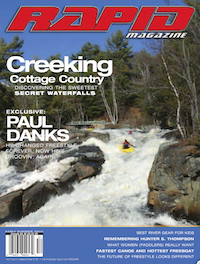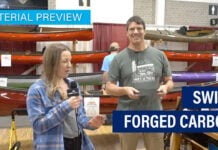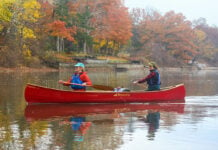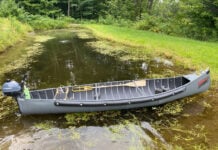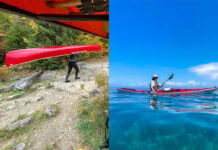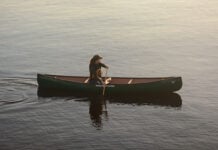In its debut on the slalom scene, the new Esquif Spark swept the 2004 US National Open Canoeing Championships on Montana’s Blackfoot River. It nabbed first, second, third and fourth places in the men’s solo rec class. With its duck-hunter camouflage Royalite shell, ash gunwales and radical cab-forward shape, the Spark is the fastest oxymoron in whitewater.
With Esquif Canoes sponsoring the last two US Nationals, it’s no surprise Esquif designer Jacques Chasse met John Kazimierczyk. Kazimierczyk is the designer, builder and coffee maker at Mill Brook Boats, specializing in compostite slalom canoes. The Spark is based on Kazimierczyk’s most successful design, the Ignitor. Chasse explains the minor differences: “The rec open canoe slalom class [for ABS canoes] doesn’t have a minimum length requirement, so we made the Spark 18 inches shorter. To keep the speed up we modified the transition and the rocker to accommodate the shorter length, without affecting the waterline.”
According to Kazimierczyk, the Spark is made for speed: “Paddling a canoe that allows you to move faster than the river, any time you want, is such a thrill.” He admits there are paddlers who say that the Spark is too long. “Too long for what?” Kazimierczyk asks. “It’s a perfect length for what it is meant to do.”
What makes the Spark so different (from a Rival, for example) is what Kazimierczyk calls his cab-forward design. He explains: “The Ignitor, like the Spark, has its widest waterline forward of the centre of the boat. The bow of the Ignitor sort of squashes the water as it moves through it. The narrower stern then follows in relatively undisturbed water. The paddler also sits slightly forward of the centreline, in the widest part of the boat. This makes entering a slalom gate slightly easier. The problem is you now have more stern behind you. It’s a trade off.”
Sitting forward of centre changes how you paddle the Spark. Forget a along forward stroke and stern pry combination; the Spark needs to be driven from the bow. Esquif team paddler Andrew Westwood explains: “The Spark responds so well to forward and cross-forward strokes that you don’t need to waste time with stern pries or even J strokes. It’s like paddling a C1.”
Besides changing stroke combinations, you need to learn how to use Spark’s edges. The hull is narrow with edges that aren’t as sharp as the Ococee and not as soft as the Rival. Engaging the outside edge of the Spark initiates both a change in direction and a transition to its other edge, in about the same amount of time it takes to cross the bow with your paddle – perfect. Using your edges to initiate a change in direction might be a new concept to many intermediate paddlers, but that’s only because they’ve been in boats that do it so poorly.
Is the Spark a winner? Three-time North American open canoe slalom champion Andrew Walker jumped in the Spark at last year’s US Nationals: “It accelerates quickly and carves gracefully through the eddies. It’s time to forget the speed-killing bob and eddying line spinout of my short boat.”
No doubt the Spark will be a popular choice for the fast and furious, but Esquif needs to be careful not to pigeonhole it in the slalom category. It could be just as popular for the bored intermediates in the eddies.
Solo open canoeing has been smoldering away for 10 years. While other manufacturers have tossed their wood in the fire pit, we know for an explosion you need a Spark.
Specs
Construction: Royalite
Length: 11’8”
Width: 25”
Depth: 15”
Shape: Asymmetrical
Rocker: bow 6”, stern 5”
Gunwale: ash
Colours: camo
Weight: 35 lbs
Price: $1325 CAD, $946 USD
